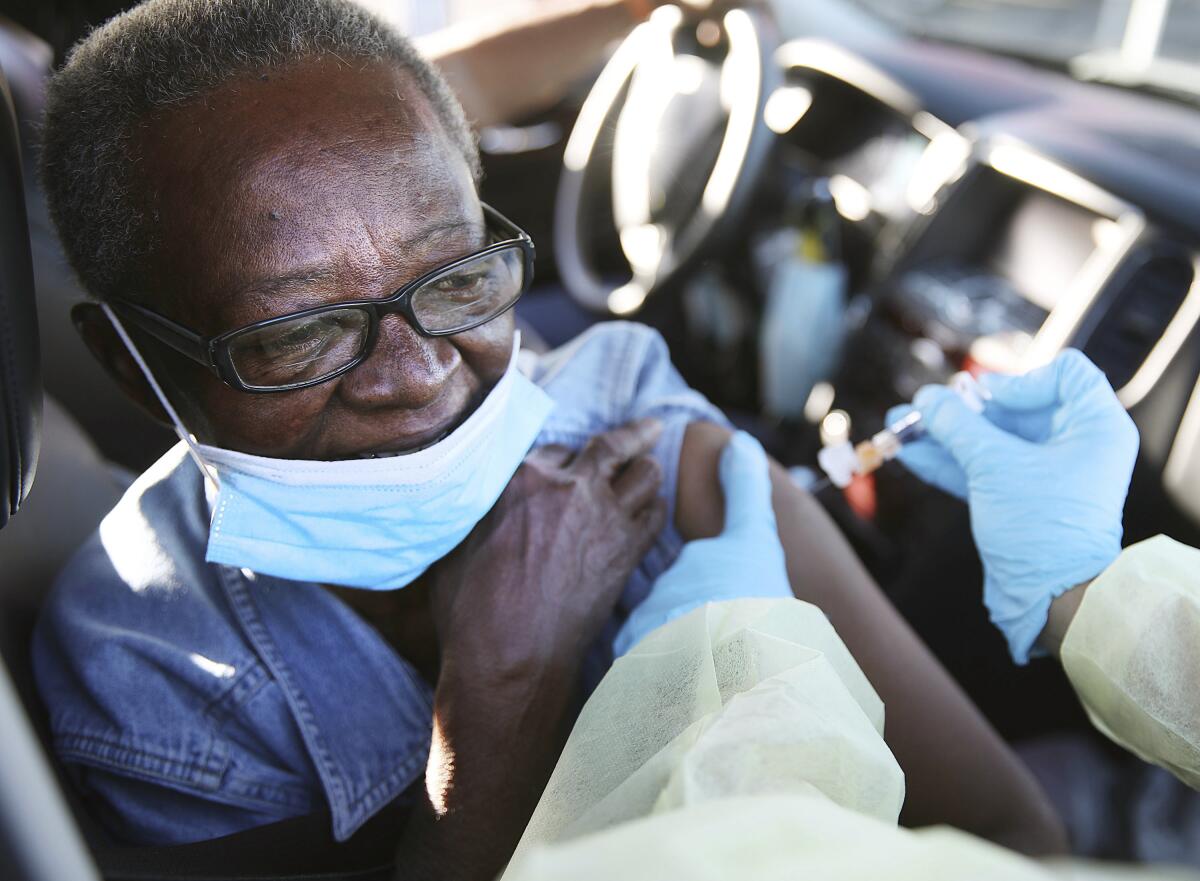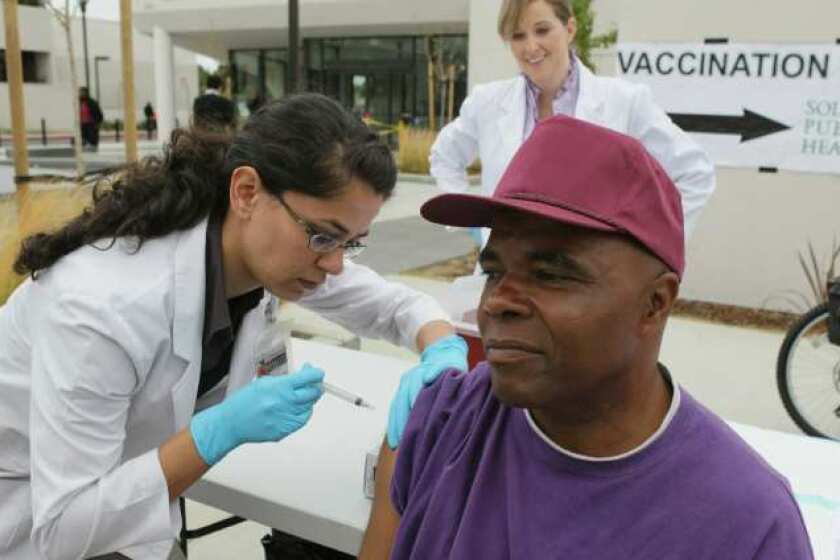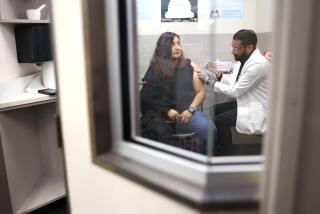High demand for flu shots? Experts hope to avoid ‘twindemic’

- Share via
October is prime time for flu vaccinations, and the U.S. and Europe are gearing up for what experts hope will be high demand as countries seek to avoid a “twindemic” with COVID-19.
“Take flu out of the equation this fall,” said Dr. Daniel Jernigan, an influenza expert at the U.S. Centers for Disease Control and Prevention.
A record number of flu vaccine doses are on the way, including at least 194 million for the U.S. alone. That might seem plenty considering that last year, just under half of adults got vaccinated and leftovers are common.
Still, there’s no way to know how many will seek shots this year. Some people are finding drugstores or clinics temporarily out of stock.
Be patient: Flu vaccine ships gradually, in batches, and the CDC and manufacturers say more is on the way.
“This year, I think everyone is wanting to get their vaccine and maybe wanting it earlier than usual,” said Jernigan, director of the influenza division in the CDC’s National Center for Immunization and Respiratory Diseases. “If you’re not able to get your vaccination now, don’t get frustrated” but keep trying.
Pharmaceutical giant Sanofi Pasteur, which is supplying nearly 250 million doses worldwide, including 80 million for the U.S., says it has shipments staggered into November.
Vaccine maker Seqirus is exploring whether it could squeeze out “a limited number of additional doses” to meet high demand, said spokeswoman Polina Miklush.
Brewing flu vaccine is time-consuming. Once production ends for the year, countries can’t simply order more. That makes for a stressful balancing act as they guess how many people will roll up their sleeves.
In the Southern Hemisphere, efforts to stop COVID-19’s spread also blocked transmission of the flu. Can a ‘twindemic’ be avoided up north as well?
Germany usually buys 18 million to 19 million doses, and this year it ordered more.
“If we manage, together, to get the flu vaccination rate so high that all 26 million doses are actually used, then I’d be a very happy health minister,” said German Health Minister Jens Spahn.
Spain purchased extra doses in hopes of vaccinating far more older adults and pregnant women than usual, along with key workers in health facilities and nursing homes.
In contrast, Poland, which last year had 100,000 doses go unused, didn’t anticipate this fall’s high demand and is seeking more.
The good news: The same precautions that help stop the spread of the coronavirus — wearing masks, avoiding crowds, washing your hands and keeping your distance — can help block influenza too.
Winter just ended in the Southern Hemisphere, and countries such as South Africa, Australia, Argentina and Chile diagnosed hardly any flu thanks to COVID-19 restrictions combined with a big push for influenza vaccinations.
But with the coronavirus still circulating and cold weather coming just as more schools and businesses reopen, there’s no guarantee that countries in the Northern Hemisphere will be as lucky with flu.
“How much flu, we don’t know — but there will be flu,” said Dr. William Schaffner, an infectious-diseases expert at Vanderbilt University.
Yes, it’s that time of year again. Here’s how and where to get a flu shot in Los Angeles and around California, including free options.
A flu vaccine protects only against influenza, not the coronavirus. And though its effectiveness varies from year to year, people vaccinated against flu don’t get as sick, avoiding pneumonia, hospitalization and death, Schaffner said.
The CDC estimated that last year the flu hospitalized 400,000 Americans and killed 22,000.
Adding flu to the toll of COVID-19 — which has killed more than 1 million people worldwide including more than 206,000 in the U.S. — would further strain hospitals. Flu and COVID-19 have similar symptoms, and even if they’re mild, Schaffner warned that confusion could result as people seek testing to find out which illness they have and whether anyone they’ve been around needs to quarantine.
Who needs a flu shot? The U.S. recommends one for everyone starting at 6 months of age. But flu is most dangerous for people older than 65, young children, pregnant women and people with certain health conditions such as heart disease, asthma and diabetes.
Most Americans with insurance can get it without a co-pay, and there are different kinds to choose from: regular shots, two types of shots that aim to give older adults a little extra protection, and a nasal spray.
The CDC doesn’t recommend one over another. If you can’t find your preferred type, “we ask people not to shop around and wait forever,” Jernigan said. “The best vaccine to get is the vaccine that’s available to you.”
The CDC this year wants states to increase flu vaccinations among Black and Latino people, who are less likely to get a shot than white people and also are at extra risk from COVID-19. Some states also are holding drive-through flu vaccination events and outdoor clinics to avoid crowds.
The social distancing that tamps down the coronavirus could also keep many people from getting the flu.
In much of Europe, those at high risk get prioritized. France has ordered 30% more flu vaccine than last year, with first shots given to the high-risk population as inoculations begin this month.
In Italy, doctors and pharmacists have expressed concern about the supply, as the health ministry conducts negotiations with vaccine producers to ensure everyone who wants the vaccine can get it. Italy also lowered the age threshold — from 65 to 60 — for receiving the flu vaccine free of charge.
Britain’s health service expects enough doses for nearly half the population but cautions that phased deliveries might mean some doctors and pharmacies won’t receive shots until later in the fall. Britain typically offers free flu vaccines to older adults, pregnant women and certain other at-risk groups, and officials are discussing whether others should qualify for a free shot this year.
The World Health Organization said last week that some countries are scrambling to make sure they’ve got enough flu vaccine. WHO encouraged any countries worried about a shortfall to give priority to health workers and older adults.








